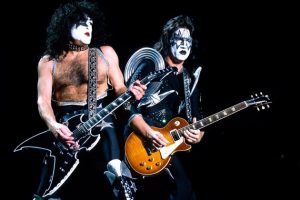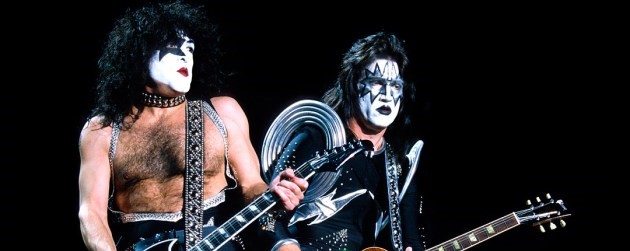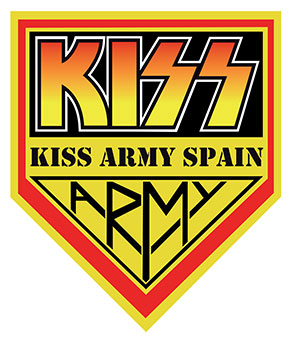El 6 de Marzo de 2002, KISS salió al escenario para dar un show privado en Jamaica con un nuevo Spaceman detrás de la máscara. Tommy Thayer hizo su primera aparición oficial como guitarrista de la banda, y a pesar de la controversia, ya llevaba involucrado en KISS desde hacía 6 años.
La salida del guitarrista original Ace Frehley llevaba siendo inminente desde hacía algún tiempo. Gene Simmons y Paul Stanley se habían cansado de los hábitos alcohólicos del Space Ace. Thayer ya estaba preparado en el banquillo, listo para ocupar el puesto si Frehley fallaba. Así fue durante la actuación de KISS en los juegos Olímpicos de Invierno en Febrero de 2002 en Salt Lake City, aunque en esa ocasión no le tuvieron que utilizar.
Nacido en 1960, Thayer había logrado cierta notoriedad con su banda Black ‘n Blue, que editó cuatro discos de estudio en los años 80. Habían contratado a Simmons para producir los últimos dos álbumes, y así surgió la conexión con KISS.

En 1989, Simmons invitó a Thayer a co-escribir material para KISS, dando como resultado las canciones “Betrayed” y “The Street Giveth, the Street Taketh Away” de Hot In The Shade. Cinco años después el guitarrista fue encargado de supervisar el proyecto del libro KISSTORY.
“A través de toda la especulación en internet, la gente empezó a decir que yo hice todos esos trabajos extraños”, le dijo Thayer a Guitar World en 2013. “Pero nada fue extraño. Yo era un ambicioso que hacía cualquier tarea que fuera necesaria, lo cual es normal si quieres llegar a alguna parte en la vida. Yo soy la prueba de que la persistencia funciona”.
La reunión de 1996 con Frehley y el batería Peter Criss había tenido a Thayer supervisando los preparativos del regreso del dúo, ayudándoles a alcanzar metas en su forma física y volver a aprenderse sus partes antes de que comenzase la gira. Luego hizo como productor en una serie de vídeos y apariciones en televisión. El gran paso adelante tuvo lugar en el marco de un creciente descontento. Frehley se había vuelto infeliz con los acuerdos contractuales, mientras que Simmons y Stanley sentían que ya no daba la talla. Su segundo periodo terminó tan tristemente como el primero, con una acritud que solo parece haberse calmado en años recientes.
Insistiendo en que se marcharía antes de ser despedido, Frehley dijo que su reemplazo “fue contratado por Paul y Gene para maquillarse y vestirse como yo y tocar mis solos de guitarra, un contrato de negocios. Mira, si no lo hubiera hecho él, habrían contratado a otro”. Pero Thayer no albergaba ilusiones de convertirse en miembro permanente de la banda. “Simplemente estaba ocupando una baja, porque no creo que ellos supieran que iban a hacerlo a largo plazo”, le dijo a Rolling Stone.
Dijo que se sintió “muy cómodo y normal” debido a su ya fuerte conexión con KISS. Pero añadió, “había un aspecto surrealista en ello también, pensando, ‘Salgo al escenario como el guitarrista de KISS’. Crecí amando a KISS. Era fan desde que empecé a introducirme en la música rock and roll cuando tenía 11 o 12 años”.
Pero muchos fans que podían entender la necesidad de un cambio en la formación estaban furiosos de que Thayer apareciera con el traje y maquillaje del Spaceman. Aunque había sigo el atuendo de Frehley, Simmons y Stanley poseían los derechos, y no tenían interés en crear una nueva imagen, como habían hecho en los años 80 para el batería Eric Carr y el guitarrista Vinnie Vincent.
“Eso fue una decisión que tomaron ellos”, le dijo Thayer a Ultimate Classic Rock. “No iban a introducir un nuevo personaje”. Aceptar la controversia era “entendible”, continuó. “Si viviste en los años 70 y KISS era fu banda favorita, puedo entender lo mucho que puede que no te guste. Pero a medida que ha pasado el tiempo, mucha gente ha cambiado de opinión”.
Mientras que Thayer había contribuido con partes pequeñas en discos anteriores, su gran momento como guitarrista llegó con el Sonic Boom de 2009 y el Monster de 2012. “Desde que llevo en la banda, he intentado ser fiel y adherirme a lo que hizo fuerte y poderoso a KISS en primer lugar”, dijo. “Pero al hacer Sonic Boom y Monster, he tenido la oportunidad de abrir las alas más. Siempre es un equilibrio entre ambas cosas. Tienes que ser fiel pero también necesito mostrar mis colores”.
Los cálculos de fuentes de internet revelan que Frehley tocó unos 665 conciertos durante su primer periodo, y unos 402 en su segunda, haciendo un total de unos 1067 conciertos. Apareció en 10 discos de estudio, desde el autotitulado disco de debut en 1974 hasta el Psycho Circus de 1998. Thayer ha tocado unos 600 conciertos hasta la fecha, y se le ha escuchado en 6 discos de estudio, desde apariciones de fondo a contribuciones en toda regla. Pero Thayer encabeza la lista en lo que se refiere a duración del servicio, habiendo anotado más de 15 años contra los 12 de Frehley.
En 2016, Simmons insistió en que KISS había jugado perfectamente sus cartas con la introducción del nuevo hombre. Le dijo a Rolling Stone, “Siempre va a haber un 5% o 10% de gente que estuvo allí en los comienzos y que se quejará sobre todo. Creo que es válido desde su punto de vista. Pero la gente se sube al tren en diferentes momentos. Si vas a ver a los Stones hoy en día, y le dices al tipo que hay junto a ti, ‘Ron Wood, no es Brian Jones’, el tipo te dirá, ‘¿Quién demonios es ese?’”, concluyó. “No tendría ni idea. Llegó a los Stones 20 o 30 años después que lo hicieras tú. Así que ¿Por qué no usaríamos el maquillaje clásico? Tenemos los derechos”.
En 2017, Thayer dijo que no estaba interesado en tratar con la controversia que rodea su presencia y su presentación. “Yo sonrío cuando escucho cosas así”, le dijo a The Aquarian. “Realmente no tiene nada que ver con lo que está sucediendo en la realidad. KISS sigue saliendo y tocando grandes conciertos y siendo el fenómeno que es. Yo le doy más mérito a ese hecho, que a lo que dicen unos cuantos bichos raros en internet. Realmente no me preocupa”.
Fuente: www.ultimateclassicrock.com
On March 6, 2002, Kiss hit the stage for a private show in Jamaica with a new Spaceman behind the mask. Tommy Thayer made his first official appearance as the band’s guitarist, and, despite the controversy, he’d already been involved with Kiss for six years.
The departure of original guitarist Ace Frehley had been looming for some time. Gene Simmons and Paul Stanley had become tired of the Space Ace’s alcoholic antics. Thayer had actually been lined up in the background, ready to take over if Frehley dropped the ball. He’d stood ready during Kiss’ performance at the February 2002 Winter Olympics in Salt Lake City, although he wasn’t called up at that time.
Born in 1960, Thayer had achieved some notoriety with his band Black ’n Blue, who released four studio albums in the ’80s. They’d hired Simmons to produce the last two, and that’s how the Kiss connection was made.

In 1989, Simmons invited Thayer to co-write material for Kiss, resulting in the songs “Betrayed” and “The Street Giveth, the Street Taketh Away” from Hot in the Shade. Five years later, the guitarist was given a supervisory role in the Kisstory book project, leading to further work with the band.
“Through all the speculation on the internet, people started saying that I did all these strange jobs,” Thayer told Guitar World in 2013. “But nothing was strange. I was just a go-getter that would do whatever task was at hand, which is normal if you wanna get somewhere in your life. I’m proof that persistence works.”
The 1996 reunion with Frehley and drummer Peter Criss had seen Thayer overseeing the duo’s return preparations, helping them reach fitness goals and relearn their parts before the tour started. He then served as producer on a series of video and TV appearances. The big step-up took place against a background of increasing dissatisfaction. Frehley had become unhappy with contractual arrangements, while Simmons and Stanley felt he was no longer delivering the goods. HIs second stint ended as unhappily as his first, with acrimony that only appears to have been settled in recent years.
Insisting that he’d quit rather than been fired, Frehley said his replacement “was hired by Paul and Gene to put on my makeup and costume and play my guitar solos — a business deal. Look, if he wouldn’t have done it, they would have hired somebody else.” But Thayer was under no illusion that he’d become a permanent member of the band. “I was basically just filling in, because I don’t think they knew what they were going to do long-term,” he told Rolling Stone.
He said the gig felt “very comfortable and normal” because of his already-strong connection to Kiss. But, he added, “there was a surreal aspect to it too, thinking, ‘I’m going on stage as the guitarist of Kiss.’ I grew up loving Kiss. I was a fan since I started getting into rock ’n’ roll music when I was 11, 12 years old.”
But many fans who could understand the need for a lineup change were infuriated that Thayer appeared in full Spaceman costume and mask. Even though it had been Frehley’s garb, Simmons and Stanley owned the rights, and had no interest in creating a new look, as they had for ’80s drummer Eric Carr and guitarist Vinnie Vincent.
“That was a decision those guys made,” Thayer told Ultimate Classic Rock. “They weren’t going to introduce a new character.” Accepting the controversy was “understandable,” he continued. “If you lived in the ‘70s and Kiss was your favorite band, I can understand how it might not have appealed as much. But as time has gone by, a lot of people have changed their mind.”
While Thayer had contributed small parts to earlier albums, his big moment as guitarist came with 2009’s return-to-form Sonic Boom and the 2012 follow-up Monster. “Since I’ve been in the band, I’ve tried to be faithful and adhere to what made Kiss strong and powerful in the first place,” he said. “But in doing Sonic Boom and Monster, I’ve had the opportunity to spread my wings more. It’s always a balance between the two. You have to be faithful – but I need to show my colors too.”
Calculations from online sources reveal that Frehley played around 665 shows during his first stint, and a further 402 in his second, delivering a total of about 1067 concerts. He appeared on 10 studio albums, from their 1974 self-titled debut to 1998’s Psycho Circus. Thayer has performed around 600 shows to date, and has been heard on six studio albums, from background appearances to fully fledged contributions. But Thayer tops the scales in terms of service length, having notched up more than 15 years against Frehley’s dozen.
In 2016, Simmons insisted Kiss had played the perfect game with the new man’s introduction. He told Rolling Stone, “There’s always going to be five percent or 10 percent of people who were there at the beginning who will complain about anything. I think that’s valid from their point of view. But people get onto a train at different times.
“If you go to see the Stones today, poke the guy next to you and say, ‘Ron Wood, he’s not Brian Jones,’ the guy says, ‘Who the f— is that?’” he concluded. “He wouldn’t have a clue. He came into the Stones 20, 30 years after you did.’ So why wouldn’t we use the classic makeup? We own it.”
In 2017, Thayer said he wasn’t interested in dealing with any controversy surrounding his presence and presentation. “I chuckle and smile when I hear things like that,” he told The Aquarian. “It really has nothing to do with what’s happening in reality. Kiss continues to go out and play big shows and be the phenomenon that it is. I give more merit to that fact, than what a few oddballs say online. I don’t really care.”
Fuente: www.ultimateclassicrock.com


